
SAN ANTONIO BREAST CANCER SYMPOSIUM 2007
A synopsis of last year's San Antonio Breast Cancer Symposium updates.
Studies described at the San Antonio Breast Cancer Symposium provide strong support for early-stage breast cancer treatments that do not rely on anthracycline drugs, with Adriamycin (doxorubicin) among the most common. The greatest concern is that, in some patients, anthracyclines appear to leave lasting damage in the heart.
As far back as 2003, data began to hint that an alternative non-anthracycline regimen, using Taxotere (docetaxel) and Cytoxan (cyclophosphamide), might offer as good or better disease-free survival for early-stage breast cancer.
The favorable trend toward a non-anthracycline alternative has continued in 2007. Researchers reported that seven years after treatment, women who received the non-anthracycline treatment have a better survival rate in general, as well as survival without cancer recurrence, something that has not been found in previous studies. At the end of the analysis, 87 percent of women who took the non-anthracycline regimen were alive, compared with 82 percent of those receiving the standard treatment.
A larger, randomized comparison is currently under way that will further compare the two types of drugs. For now, the decision to use anthracycline drugs will come down to each woman and her doctor, weighing the fear of recurrence against the fear of heart damage and other concerns.
After a 12-year study, Canadian researchers have not discovered any difference between women who received hypofractionated radiation and those treated on a standard schedule. Hypofractionated radiation uses larger doses of radiation on a shorter schedule, sparing women weeks of radiation treatments.
San Antonio
At least four randomized trials have not found major differences in either the effectiveness or side effects between the two approaches. The latest study, presented in , found results were practically identical in the risk of recurrence, breast appearance, and survival. Risk of recurrence was about 6 percent in both groups, and survival was 84 percent. The study involved more than 1,000 women whose cancer had not moved into the lymph nodes.
Another piece of the puzzle was revealed on the use of Oncotype DX, a high-tech gene test, to provide more precise estimates on risk of recurrence and which breast cancer patients will benefit the most from chemotherapy. The differences in the study presented is it included women with positive lymph nodes (Oncotype DX has only been used for node-negative cases) and looked at a more contemporary chemotherapy regimen containing Adriamycin.
Ten years after treatment, women with low gene test scores were shown not to benefit from chemotherapy. Disease-free survival was 60 percent for women treated with tamoxifen alone compared with 64 percent for women who received chemotherapy plus tamoxifen. Those with high scores, however, had significant improvement in disease-free and overall survival. Disease-free survival after 10 years was 43 percent in the tamoxifen-alone group compared with 55 percent for women treated with chemotherapy plus tamoxifen.
New data shows Zometa (zoledronic acid), a type of bisphosphonate, appears to increase bone mineral density among women receiving aromatase inhibitors, and the benefit lasts for at least three years.
Scientists have known aromatase inhibitors, which block estrogen production in postmenopausal women, can accelerate bone loss and raise the risk of fracture. Doctors are now testing whether drugs that treat osteoporosis might offset the bone-thinning tendencies of cancer treatment.
At SABCS, researchers reported that the benefit of Zometa held up for three years in the 602 women with early-stage breast cancer enrolled in the Zometa-Femara Adjuvant Synergy Trial (Z-FAST). Half of the women received infusions of Zometa two times a year from the beginning of their treatment. The other half had their bone density monitored, and received the drug only if the density fell below a certain level.
After 36 months, the women who had received Zometa upfront had experienced a 3.72 percent increase in spine density. The women who had received no or delayed treatment had a 2.95 percent drop in bone density. Experts are now developing recommendations for use of the drug.
Read more of CURE's coverage of the 31st annual San Antonio Breast Cancer Symposium at





